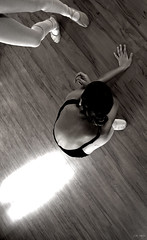![I need a break... I need a break...]()
- Image by piotr.amigo via Flickr
All the way to the floor?
Absolutely! In fact, dancers benefit from regular practice “à terre.” Many professionals make it a part of their routine and there’s no reason you or your students cannot do the same.
Benefits
- Translating technique and alignment principles to the floor can provide information which a dancer can use to improve movement execution. It encourages concentration on alignment and efficiency of the muscles. The body moves through patterns common in ballet and other movement disciplines but free from the usual affects of gravity. This provides opportunity to correct bad habits and gain deeper understanding of movement principles.
- Floor barre is also a method favored by dancers working through injury. The techniques can not only be rehabilitative, but may also increase the dancer’s awareness of weaknesses and tendencies which may have led to injury in the first place.
- Floor barre may also be used before or outside of class to strengthen, tone, work, or warm-up the muscles in a way that will support the dance techniques performed in class. Even though floor barre may involve lying or sitting on the floor, it is definitely not rest for the mind or body and can actually awaken sensitivity to things are being ignored during vertical practice.
Floor Barre Methods
There are a number of codified floor barre techniques that are taught throughout the world. Most of the most well-known methods were developed during the mid-20th Century.
The Zena Rommett Floor-Barre Technique®
In the United States, The Zena Rommett Floor-Barre Technique® has been widely influential and, through the Floor-Barre Foundation®, has certified a number of practitioners world-wide. You can learn more about Zena’s work and the non-profit organization that promotes and preserves her legacy, at www.floor-barre.org.
A series of 5 DVD’s are available for purchase at the website. These include exercises for all levels of dancer, including professionals and young students. Truly teaching these techniques to your class requires a level of experience and understanding of the method. Dance instructors, however, will be positively influenced by the insights and work captured in the videos – I know my experience with the Series III video in college strongly affected me and my teaching.
A new book, Zena Rommett: The Art of Floor-Barre: Ballet Class on the Floor: A Conditioning Program for Dancers, Athletes, the Injured, and the Elderly
Barre au sol — Methode Boris Kniaseff
Also widely recognized is a technique developed by Russian dancer Boris Kniaseff in the 1950s. His barre au sol, has been carried on by dancers and teachers, Jacqueline Fynneart, Zizi Jeanmaire, Roland Petit, and Stéphane Dalle. According to Jacqueline Fynneart in an interview published at Danza Ballet, the technique is meant to be added to a traditional class (rather than as a replacement) and was “developed by combining Graham style floor exercises with classical technique.” Characteristically, Kniaseff’s barre au sol method is accompanied by music. A 3-DVD set by Stéphane Dalle introduces beginning, intermediate, and advanced levels of the method. You can purchase these at Yumiko Takeshima’s online store.
Maria Fay’s Floor Barre
Maria Fay is a renowned teacher who has taught for the Royal Ballet School, the Royal Academy of Dancing, and other acclaimed schools and companies. Her floor barre technique has yet to be widely recognized in America but is practiced in Europe, Canada, and other locations world-wide. Only one teacher has been acknowledged by Fay and granted permission to carry on and experiment with her ideas and teachings. Protégé Christina Beskou is based in Athens, Greece and appears in videos detailing a Basic and Advanced session in Fay’s Floor Barre method. Excerpts of the videos are on YouTube (the basic video is embedded below) and can also be seen at Ms. Beskou’s website. Maria Fay’s Floor Barre book can be found at Dance Books, an international publishing house based in the U.K.
Other Resources

Other options on video include the New York City Ballet Workout DVD. The Floor Barre section is relatively short (about 10 minutes) and combines elements of a floor barre with Pilates-type mat work. You can get The Complete Workout, Vol. 1 and 2
A VHS titled Ballet Floor Barre: A Warm-Up and Conditioning Program has limited availability. Dance Horizons is one of the few places I found selling this. If you have experience with this video’s contents, share your thoughts in the comments below. I’ve seen it recommended on message boards but have never viewed it.
The above post topic has been suggested and chosen via the Skribit suggestion box. What do you want to see covered on DA? Let me know by visiting the website and clicking on the Suggestions? tab! You can follow suggestions to increase their visibility and receive an update when it is posted.
Free Download
Nichelle’s This-N-That Floor Barre is a series of exercises which I’ve used with my own students. It includes some of my favorite floor work exercises I’ve collected over the years. It could be practiced in parts as a warm-up or, once learned, performed seamlessly (it’s approximately 30 minutes of continuous material) and utilized as an alternative or supplementary class for dancers in any discipline.
To access the download all you have to do is join Subscriber PLUS. You can choose to have new articles delivered to your inbox as well as receive additional news, offers, and articles from our archives in a monthly newsletter.


![Reblog this post [with Zemanta]](http://img.zemanta.com/reblog_e.png?x-id=99c20933-ee73-47c9-a145-b832b586330f)